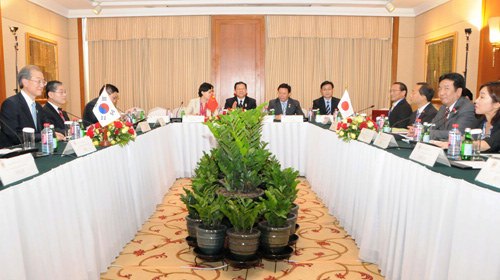|
 |
|
TRILATERAL BONDS: Officials launch negotiations on the China-Japan-South Korea free trade agreement in Phnom Penh, Cambodia, on November 20, on the sidelines of the East Asia Summit (XINHUA) |

Compared with the rocky U.S. and European economies, the continuously vibrant economic scene in East Asia has been a focus of international attention. Meanwhile, the United States is shifting its strategic focus to the world's most economically promising region. The move by Washington, which seeks to guarantee its dominance in the Asia-Pacific region, has caused a backlash by helping surface regional political and security problems while clashing with East Asian regionalism. Asia-Pacific integration has therefore entered a new phase.
Economic cooperation
New plans for regional economic cooperation highlight East Asia's prospects. During the East Asia Summit in November 2012, leaders from 10 ASEAN nations and its six dialogue partners—China, South Korea, Japan, India, Australia and New Zealand—announced the launch of negotiations on an East Asian free trade agreement (FTA), the Regional Comprehensive Economic Partnership (RCEP). China, Japan and South Korea also proclaimed an official start to trilateral FTA negotiations.
The RCEP is not a sudden impulse of East Asian countries. East Asian regionalism emerged following the end of the Cold War as part of the larger Asia-Pacific integration process. After the U.S.-dominated NAFTA (North American Free Trade Agreement) entered into force in 1994, East Asian countries began to consider building a cooperation framework of their own. Meanwhile, the greed-driven economic devastation leveled on East Asian countries by the United States during the Asian financial crisis in 1997 further spurred the integration and cooperation of East Asian countries. At the beginning of the 21st century, regional countries put forward the idea of forming an East Asian community. East Asian countries have taken a pragmatic approach to promoting regional free trade, as evidenced by their efforts to advance specific programs such as regional connectivity and financial cooperation and pursue bilateral FTAs before multilateral ones.
After the First East Asia Summit was held in 2005 by 16 countries, East Asian nations began to ponder a 10+6 economic cooperation model. Based on a joint proposal by China and Japan, ASEAN proposed the RCEP at the East Asia Summit in November 2011.
There are fundamental differences between the RCEP and the Trans-Pacific Partnership (TPP) led by the United States. The former emphasizes adopting a gradual path in promoting free trade and opening up member nations' markets in light of their development gaps, while the latter seeks to push the Asia-Pacific region into playing by a set of rules dominated by the United States. In addition, ASEAN would play a leading role in promoting the RCEP. It would be established on the basis of the existing economic partnership agreements and FTAs between ASEAN and the six countries. The RCEP adopts the principle of openness, with highly transparent rules. The rulemaking process of the U.S.-led TPP, however, is influenced by Washington's political intentions, politically exclusive and less transparent.
The launch of negotiations on the RCEP and the trilateral FTA of China, Japan and South Korea shows that regional economic cooperation in East Asia is developing from a bilateral mode to one that is regionally comprehensive. The RCEP and the TPP together form a competitive Asia-Pacific economic cooperation pattern, ushering in a new phase of regional economic integration.
U.S. rebalancing
Besides economic integration in the region, East Asia is also undergoing changes in political and security fields. In particular, the rebalancing strategy of the United States is having a great impact on the regional political landscape.
|
